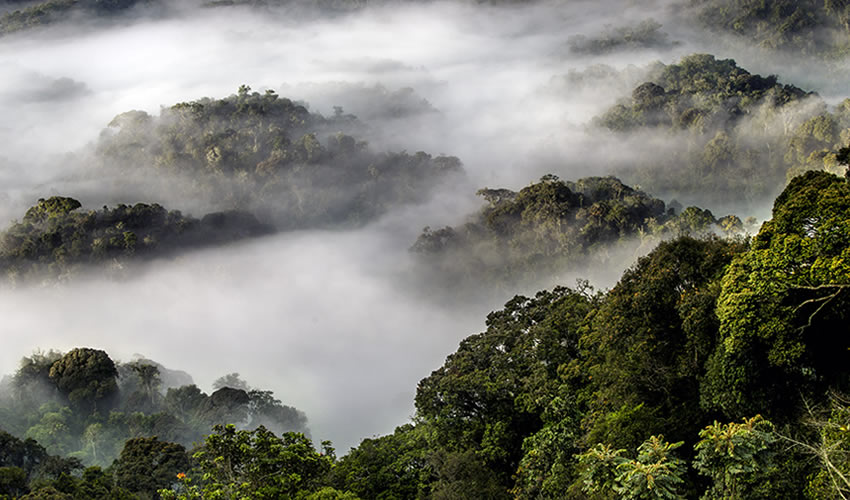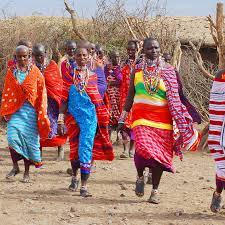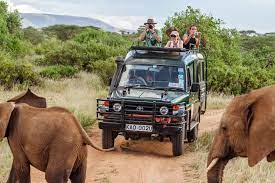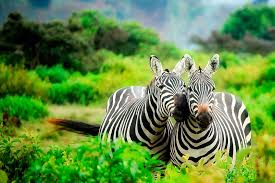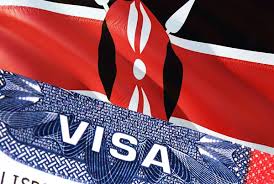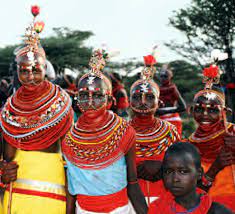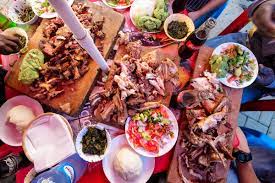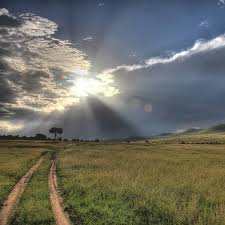Overview
The remarkably accessible Nyungwe Forest National Park was first protected in 1933. Today it contains the largest remaining tract of montane (mountain) rainforest anywhere in East Africa. Montane rainforests are a rare and unique ecosystem, found only in mountainous areas above 1,000m/3,281ft within the tropical belt. At Nyungwe Forest NP, the main attraction is primates – 13 species, including chimpanzees, are here. Another highlight is the suspended canopy walk, offering a bird’s eye view into the dense forest.
Best Time to Visit
Nyungwe Forest is open for chimpanzee tracking and hiking throughout the year. The wet months, from October to May, are the best time for chimp tracking and forest birding, but general hiking and spotting other primates might be easier in the drier months, from June to September.
Best Time October to February (These months are excellent for chimp tracking and avoid the worst rains)
High Season June to September (The park is busier as it is the most favorable time for gorilla tracking in Rwanda)
Low Season March, April, May, October and November (These are the peaks of the rains)
Best Weather June to September (Least rain)
Worst Weather March and April (Most rain, forest trails are slippery)
June to September –Dry Season
- Drier trails make hiking easier and more pleasant
- The sun is more likely to break through the clouds
- Chimpanzee tracking is more hit-and-miss
- Some of the special forest birds might be difficult to find
October to May –Wet Season
- Chimpanzee tracking is best at this time as their food is plentiful
- Forest birding is at its best and migratory birds are present
- Rain can make forest trails challenging
- It might rain for days at a time
Getting There
Ariadne is a renowned Africa expert. She and her husband form a team who write and update many Bradt guides, including the guide to Rwanda.
Kigali International Airport (KGL) will be your entry point into Rwanda. It is about 10km/6mi from the capital, Kigali. Nyungwe Forest NP is in the south of the country 200km/124mi from Kigali, 87km/54mi from Huye and 55km/34mi from Rusizi. The drive takes about four to five hours from Kigali, two to three hours from Huye and about one hour from Rusizi. Usually, Nyungwe Forest is visited as part of a 4×4 tour around the country with a driver-guide. Akagera Aviation offers charter helicopter transfers to anywhere in the country, including Nyungwe For
Activities
- Chimpanzee Tracking
- Colobus Monkey Tracking
- Trekking Nyungwe Forest
- Birdwatching
- Canopy Walkway
Chimpanzee Tracking
They may pale in size when compared to the hulking masses that are the mountain gorillas, but there is no denying the affinity that we humans have for chimpanzees. Sharing an estimated 94% of our genetic material, chimps display an incredible range of human-like behaviours ranging from tool use to waging war. Chimps are highly sociable creatures, and one of the few primates to form complex communities ranging upwards of 100 individuals. During the day these communities break down into smaller units that forage for food, a behaviour that has been dubbed ‘fission-fusion’ by anthropologists. Since they cover a greater daily distance than the relatively docile gorilla, chimpanzee tracking (US$90 per person) is a much more uncertain enterprise. Chimpanzee habituation in Nyungwe is still very much a work in progress, and although you will almost certainly encounter them, it might not be all that close up. This is especially so because Nyungwe’s chimps seem to spend longer periods of time high in the tree tops than many other East African chimps. Much like gorilla tracking, you need to be prepared for lengthy hikes that can take up to several hours. However, the vegetation on the forest floor is much less dense than in the Virunga mountains where the gorillas live, so the walk is generally a little less tiring. In the rainy season you have a good chance of successfully tracking the chimps on the coloured trails (a network of trails of varying levels of difficulty), though in the dry season they have a tendency to head for higher elevations. Although there are groups of chimps throughout Nyungwe, the habituated group that most people are taken to is actually located in the Cyamudongo Forest, a very small, isolated ‘island’ of forest surrounded by tea estates a little over an hour’s drive from the park office at Gisakura. This group consists of about 40 individuals. At certain times, though, visitors might be taken to see a second habituated group, the Uwinka group, which is the largest with around 65 individuals. That said, this group, which is usually found within 12km of the Uwinka Reception Centre, is harder to access. Whichever group you end up visiting, having a car is something of a necessity for chimp tracking, as you’ll need to arrange transportation for you and your guide to the trailhead. Be prepared for an early start – usually 5.30am from Gisakura. Porters are available at Cyamundongo (US$10).
Colobus Monkey Tracking
A subspecies of the widespread black-and-white colobus, the Angolan colobus is an arboreal Old World monkey that is distinguished by its black fur and long, silky white locks of hair. Weighing 10kg to 20kg, and possessing a dexterous tail that can reach lengths of 75cm, Angolan colobus are perfectly suited to a life up in the canopy. Colobi are distributed throughout the rainforests of equatorial Africa, though they reach epic numbers in Nyungwe Forest National Park. While they may not be as a charismatic as chimps, colobi are extremely social primates that form enormous group sizes – one of the two semi-habituated troops in Nyungwe numbers no fewer than 500 individuals. As you might imagine, finding yourself in the presence of literally hundreds of primates bounding through the treetops can be a mesmerising experience. Curious animals by nature, colobi in Nyungwe seem to almost revel in their playful interactions with human visitors. Troops of Angolan colobus maintain fairly regimented territories, which is good news for those planning a colobus track (US$60 per person), as the semi-habituated group in Nyungwe tends to stick to the coloured trails. While watching wildlife is never a certainty, generally the trackers can find the colobus monkey troop in an hour or so. There is a smaller, and often more accessible troop, of around 50 individuals near the Gisakura Tea Plantation. Be sure to ask which troop you’ll be tracking when you make your reservation. This second troop is less worthwhile to visit as the walk is only about two to five minutes from the Gisakura park office and it feels like a lot of money to pay to stand in a tea field looking at monkeys you could almost see without leaving the park office!
Colobus Monkey Tracking
A subspecies of the widespread black-and-white colobus, the Angolan colobus is an arboreal Old World monkey that is distinguished by its black fur and long, silky white locks of hair. Weighing 10kg to 20kg, and possessing a dexterous tail that can reach lengths of 75cm, Angolan colobus are perfectly suited to a life up in the canopy. Colobi are distributed throughout the rainforests of equatorial Africa, though they reach epic numbers in Nyungwe Forest National Park. While they may not be as a charismatic as chimps, colobi are extremely social primates that form enormous group sizes – one of the two semi-habituated troops in Nyungwe numbers no fewer than 500 individuals. As you might imagine, finding yourself in the presence of literally hundreds of primates bounding through the treetops can be a mesmerising experience. Curious animals by nature, colobi in Nyungwe seem to almost revel in their playful interactions with human visitors.
Troops of Angolan colobus maintain fairly regimented territories, which is good news for those planning a colobus track (US$60 per person), as the semi-habituated group in Nyungwe tends to stick to the coloured trails. While watching wildlife is never a certainty, generally the trackers can find the colobus monkey troop in an hour or so. There is a smaller, and often more accessible troop, of around 50 individuals near the Gisakura Tea Plantation. Be sure to ask which troop you’ll be tracking when you make your reservation. This second troop is less worthwhile to visit as the walk is only about two to five minutes from the Gisakura park office and it feels like a lot of money to pay to stand in a tea field looking at monkeys you could almost see without leaving the park office!
Trekking Nyungwe Forest
In addition to tracking primates, Nyungwe Forest National Park has a number of superb walking trails that mostly begin at the Uwinka Reception Centre. It’s not possible to walk in the park without a guide, and one is included when you pay your trek fees. Walks begin at set times; the first departures are around 9am, with further departures around 11am and 2pm.
Nature Walks
This network of trails was constructed in the late 1980s in an attempt to open up Nyungwe to tourists. While tourism in the national park remains relatively low-key, these six trails are nevertheless reasonably well maintained. Each trail is marked with a different colour. Hikers can choose trails ranging from the 2km-long Buhoro Trail, a proverbial walk in the woods, right up to the 10km-long Imbaraga Trail, which winds steeply up forested slopes and requires about six hours. Some of the most popular trails include the Igishigishigi Trail (2.1km, about 1½ hours), which has spectacular tree ferns and great views, and the Umuyove Trail (5.5km, 3½ hours), which has birds, colourful flowers, a waterfall and large mahogany trees. The Irebero Trail (3.6km, three hours) is noted for its stunning viewpoints. Although you need to specifically request to engage in either chimpanzee or colobus tracking, in theory you could run across either primate while hiking the coloured trails. Even if you don’t come across these two star billings, you’re likely to spot some of Nyungwe’s other 11 primates, as well as a whole slew of birdlife, and possibly even the odd mammal or two. These trails originate from the Uwinka Reception Centre and cost US$40 per person. A number of walking trails are also available in the Kitabi area and begin at the Kitabi Booking Office. They’re much less known than the ones around Uwinka. A guide is also compulsory and is included in your trekking fee (US$40 per person).
Waterfall (Isumo) Trail
While not as popular as the nature walks, the Waterfall Trail (per person US$50) is a stunner of a hike and one of the highlights of Nyungwe. It’s one of the few treks that start from the Gisakura side of the park and takes three to five hours to complete depending on your fitness level. The trail winds up and down steep hillsides through primeval-looking rainforest where the trees are festooned in vines and mosses and the air is heavy and damp. The highlight (quite obviously) is a remote waterfall, where you can take a shallow dip and refresh your body after the hot and humid hike.
Kamiranzovu Trail
If you have your own wheels, the Kamiranzovu Trail (per person US$40) starts somewhere between Uwinka and Gisakura, and runs for about 4km to Kamiranzovu Swamp. Sadly, the last elephant was shot here in 1999, though the swamplands are still your best bet for spotting other large mammals. Even if you don’t come across any other fauna, this trail is particularly famous for its rare species of orchids and birds, including the greater swamp warbler.
Uniqueness
Rwanda – the land of a Thousand Hills is home to many natural wonders and Nyunge Forest is one of them. Nyungwe Forest in Rwanda is covering an area of over 1000 square kilometers – however, it is even larger than that since it extends into Burundi where it is Kibira National Park. Nyungwe Forest is the largest tropical Afro-Montane Rainforest in East or Central Africa and a rainforest it is, receiving of 2000 mm of rain each year and it is Rwanda’s largest water catchment area – home to 2/3rds of all Rwanda’s water. The forest feeds both the River Congo and the River Nile with water. When you reach Nyungwe Forest you come here on winding roads (drive time from Kigali 4 – 5 hours) through vast tea fields and then there it is Nyungwe Forest National Park, like emerging with its vastness like a National Geographic Video – only better since you are here in that vast forest with its endless Kamiranzovu Swamp, trails throughout, the famous Forest Canopy Walk, the only one in East Africa (there are only 3 in Africa), opportunities for Birding, Primate Viewing including Chimpanzee Tracking, taking in the flowers such as the various Orchids found here and the countless of butterflies they attract.
Nyungwe Forest Park is not a compact park but a vast forest and the things to do and see here take some planning so that your time on safari is not wasted with drive times. You can find almost 300 different bird species, hundreds of butterflies and orchids, and over 75 different species of mammals – including 13 primates, there have also been unconfirmed sightings of Golden Monkeys. Nyungwe Forest National Park with its countless of natural wonders is not be missed if you are coming to Rwanda – it will be one of those added Plus Items to Mountain Gorilla Tracking in Rwanda.

